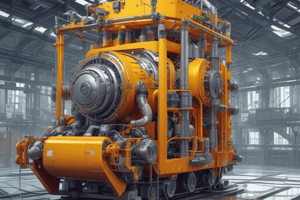Podcast
Questions and Answers
Polycondensation involves the creation of water as a byproduct.
Polycondensation involves the creation of water as a byproduct.
True (A)
Thermosets can be melted and reshaped after hardening.
Thermosets can be melted and reshaped after hardening.
False (B)
Amorphous plastics are disordered and brittle.
Amorphous plastics are disordered and brittle.
True (A)
Thermoplastics have strong covalent bonds that remain intact at high temperatures.
Thermoplastics have strong covalent bonds that remain intact at high temperatures.
Polyaddition requires a catalyst and high pressure or temperature to proceed.
Polyaddition requires a catalyst and high pressure or temperature to proceed.
Elastomers are rigid and do not change shape upon temperature increase.
Elastomers are rigid and do not change shape upon temperature increase.
Semi-crystalline plastics are partially ordered and often have better thermal resistance than amorphous plastics.
Semi-crystalline plastics are partially ordered and often have better thermal resistance than amorphous plastics.
Polymerization reactions include only polycondensation.
Polymerization reactions include only polycondensation.
Flashcards
Polycondensation
Polycondensation
A chemical reaction where two or more monomers (small molecules) join together to form a polymer (large molecule), releasing a small molecule like water as a byproduct.
Polyaddition
Polyaddition
A chemical reaction where monomers combine without releasing any byproducts. The monomers usually have double bonds that break, forming new bonds with other monomers.
Thermoplastics
Thermoplastics
Plastics that can be repeatedly melted and reshaped without degrading. They have long, chain-like molecules that can slide past each other when heated.
Thermosets
Thermosets
Signup and view all the flashcards
Elastomers
Elastomers
Signup and view all the flashcards
Amorphous Thermoplastics
Amorphous Thermoplastics
Signup and view all the flashcards
Semi-crystalline Thermoplastics
Semi-crystalline Thermoplastics
Signup and view all the flashcards
Hydrogen bonds
Hydrogen bonds
Signup and view all the flashcards
Study Notes
Plastics Composition
- Plastics are composed of carbon-hydrogen bonds.
- Monomers form polymers.
- Two main polymerization reactions exist: polycondensation and polyaddition.
Polycondensation
- Combines two or more different or identical substances.
- Creates water as a byproduct, which must be managed.
- Examples include polyester, polyether, and polyamide.
Polyaddition
- Combines two identical or different substances.
- Rearranges the atoms of the monomers.
- Requires a catalyst and high pressure/temperature.
- Produces no byproducts.
Types of Plastics
- Plastics are categorized into thermoplastics, elastomers, and thermosets.
Thermoplastics
- Melt when heated.
- Covalent bonds are strong and resistant to temperature.
- Also have intermolecular forces (e.g., hydrogen bonds), which can weaken with increasing temperature.
- Can be linearly plastically and deformable.
- Amorphous thermoplastics are disordered (glassy, transparent, brittle).
- Semicrystalline thermoplastics are partially ordered with crystallites (ductile loops, opaque, better thermal resistance).
- Examples include: PP (Polypropylene), PE-HD (high-density polyethylene), PE-LD (low-density polyethylene), PE-LLD.
Elastomers
- Soften at room temperature.
- 2D or 3D network with large meshes and connections between chains.
- Have rubber-elastic properties, allowing them to spring back.
- Examples include EPDM (ethylene-propylene-diene-monomer).
Thermosets
- Have a 3D network structure with strong connections between chains.
- Rigid structure.
- Harden chemically, not through melting.
- Resistant to high temperatures.
- Can't be melted again without decomposing.
- Examples include Bakelite, Melamine formaldehyde.
Studying That Suits You
Use AI to generate personalized quizzes and flashcards to suit your learning preferences.




